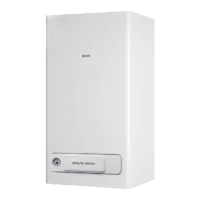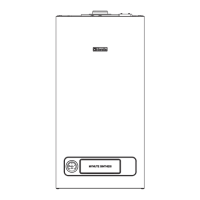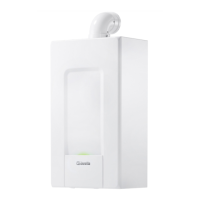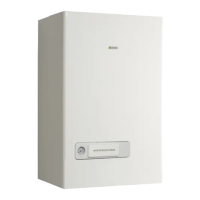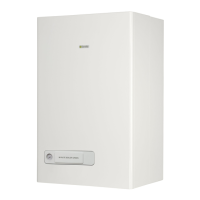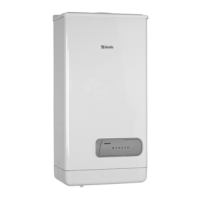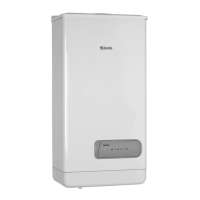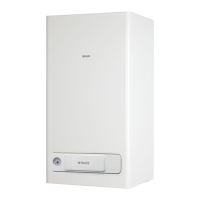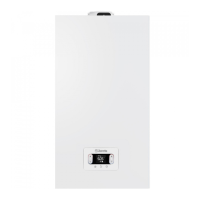9
ENGLISH
3.16 Filling the heating system and eliminating air
Note: the rst lling operation must be carried out by turning the lling tap (B - g. 19) with
the boiler OFF.
Note: each time the boiler is powered up, the automatic venting cycle is carried out.
Note: the presence of a water alarm (40, 41 or 42) does not allow the venting cycle to be
carried out. The presence of a domestic hot water request during the venting cycle interrupts
the venting cycle.
Once the hydraulic connections have been made, ll the heating system as follows:
- Set the boiler to OFF by pressing button 1
- Open the plug of the air vent valve (A - g. 19) by two or three turns to allow the
continuous bleeding of the air, and leave the valve cap (A - g. 19) open.
- Connect the supplied silicone pipe to the de-aeration tap (D - g. 19) and take a bucket
to collect any water that may come out after bleeding.
- Open the de-aeration tap (D - g. 19).
- Turn on the lling tap (B - g. 19).
- Wait until the water comes out continuously from the de-aeration tap (D - g. 19), then
close it.
- Wait for the pressure to increase: check that it reaches 1-1.5 bar; then close the system
lling tap (B - g. 19).
Note: if the mains pressure is less than 1 bar, keep the system lling tap (B - g. 19) open
during the venting cycle and close it once it has nished.
- To start the vent cycle shut off the electrical power for a few seconds; connect the power
again leaving the boiler OFF. Check that the gas tap is closed.
- At the end of the cycle, if the circuit pressure has dropped, open the lling tap (B - g. 19)
again to bring the pressure back up to recommended levels (1-1.5 bar)
The boiler is ready after the vent cycle.
- Remove any air in the domestic system (radiators, zone manifolds, etc.) using the bleed
valves.
- Once again check that the system pressure is correct (ideally 1-1.5bar) and restore the
levels if necessary.
- If air is noticed when operating, repeat the vent cycle.
- Once the operations are nished, open the gas tap and ignite the boiler.
At this point it is possible to carry out any heat request.
3.17 Draining the heating system
Before draining, set the boiler to OFF and shut off the electrical supply setting the system's
main switch to “off”.
- Close the heating system's taps (if present).
- Connect a pipe to the system discharge valve (C - g. 19), then manually loosen it to let
the water ow out.
- Once the operations have been completed, remove the pipe from the system discharge
valve (C - g. 19) and close it again.
3.18 Emptying the domestic hot water circuit
Whenever there is risk of frost, the domestic hot water system must be emptied in the
following way:
- turn off the main water supply tap
- turn on all the hot and cold water taps
- drain the lowest points.
3.19 Condensate siphon
When the boiler is rst started the siphon for collecting the condensate is empty.
When eliminating air from the boiler, the siphon lls.
- Slowly open the de-aeration tap (A - g. 19) and leave it open until the amount of water
contained in the siphon reaches the ledge.
- Close the de-aeration tap (A - g. 19)
- Check that there are no leaks from the SRD device connection zone and that the device
allows the liquid to run off correctly.
- Check that the system pressure has not dropped below 1 bar. If necessary, ll the system.
Repeat this operation during maintenance work.
CHECK THAT THE CONDENSATE DRAIN OUTLET SIPHON CONTAINS WATER, IF IT
WAS NOT FILLED PROCEED AS DESCRIBED ABOVE.

